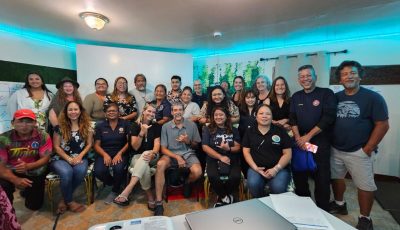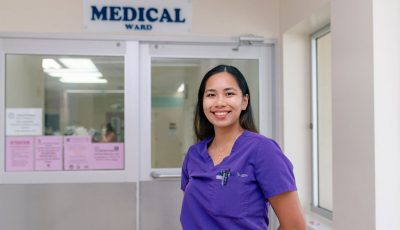‘Several factors behind CHC struggles’
The Commonwealth Health Center is struggling not just because of the difficulty of addressing about 50,000 people’s health issues in a facility built to serve a population of less than 20,000, but more of a collection of challenges that have piled up.
Commonwealth Healthcare Corp. chief executive officer Esther Muña told Saipan Tribune that a lot of factors contribute to the worries of CHC.
One of its biggest problems is the lack of manpower, according to Muña.
“We want to make sure that there is a nurse there that would be able to take care [of the patient]. When we are transferring custody of the patient from the emergency room to the medical wards, we want to make sure that we have nurses available. That means we need to make some calls to make sure [we have the manpower],” she said.
That sometimes results in calling nurses to go to work earlier than expected.
Muña said the workload on the nurses is taxing.
“Imagine a nurse who is working 16 hours a day, getting a couple of hours of sleep, and is called back again because of the fact that there are new patients. It happens and is one of the biggest problems that we are having,” she added.
Hospital administrator Jesse Tudela agrees. He said that nurses are greatly outnumbered by the patients. Because of this, nurses are also affected.
“For the Medical/Surgical Unit, or MedSurg, the recommended patient-to-nurse ratio should be five patients to one nurse. That is not happening in MedSurg. It is running, at times, seven patients to one nurse,” said Tudela. “That is two additional patients for one nurse. It causes them to overwork and not have enough breaks. [The nurses’] health may also be affected down the road.”
Tudela added that the CW1 issue has also been bottlenecking the capacity for CHC to hire nurses.
“We are pressing hard to try and replace [nursing vacancies] but again, another factor is the CW cap. We are unable to recruit foreign nurses because the cap has been met and [CHCC] is unable to petition the nurses with U.S. Citizenship and Immigration Services,” he added.
Tudela said increasing the number of CW slots would be beneficial to address the manpower issues all over the island.
“The first couple of nurses affected by the CW crisis have their renewal dates this coming April. Until now, there is still no increase in CW slots. The next batch is in July, which is a lot more nurses—about 40—followed by an August group and a September group,” he said.
Muña said CHCC is looking at other versions of work visas so as to stay away from the CW issue.
“We are trying to do everything we can to make sure our staff are staying. [CHC] is also trying to look for ways to recruit staff.”
Gambling aftermath
Muña said the casino also affects the amount of patients that are coming in to seek medical assistance at CHC.
“I hate to say this, but [according to] a lot of studies, when you open a casino, that is what happens,” she said.
Muña clarified that she is not attacking casino establishments but rather the gambling habits that casinos bring with them. Muña pointed out that the addition of a casino comes with a population influx.
“We are not saying that the casino is the whole problem; we are saying that this is one of many factors that affect the high CHC census,” she said.
“[Gambling] affects healthcare. We are seeing the effects of it. That is why you have the business gross revenue tax, or the BGRT. There is a reason why there are a lot of taxes associated with bringing up the casino and health,” she added.
According to Christian Nordqvist of medicalnewstoday.com, problem gambling, a condition that manifests in people who are addicted to gambling, causes certain psychological and physical health including depression, migraine, intestinal disorders, anxiety, and other problems.
With economic growth comes various risks and even more responsibility, Muña said.
“We say this because [casinos] bring in workers and they bring in tourists. They all access our services, not just the locals. [Healthcare] does not just go to the locals, healthcare go out to everybody,” she said.
For Saipan specifically, the construction industry, which is also experiencing a boom due to all the ongoing projects, contribute to the number of patients at CHC. Sources say workers from various construction entities, which include victims of accidents, are seeing about three to four incidents a day.
Financial worries
Muña also expressed concerns about their financial situation. CHC is a hospital that relies on a reimbursement payment system.
“We are supposed to make sure that services are available before being reimbursed. This means we have to have the medical supplies on hand to make sure these patients have these services [available to them] [before CHC] gets paid later,” she said.
If the hospital spends $1,000 a month on medical supplies, as the population goes up, and more people show up with more severe illnesses, $1,000 would not be enough to address the health issues of unexpected patients, leaving CHC to shoulder multiple patient bills.
The lone hospital in the CNMI opened to the public in 1986 and was built to serve a population of less than 20,000. More than 20 years later and an estimated 50,000 population, the hospital is struggling to keep up.



























